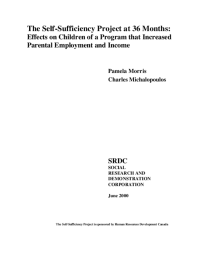The Self-Sufficiency Project at 36 Months: Effects on Children of a Program that Increased Parental Employment and Income
For several decades, policymakers have implemented policies designed to encourage welfare recipients to work. Especially promising is the use of financial work incentives, which have proved to increase employment, reduce welfare dependence, and at the same time increase family income. Little is known, however, about how policies that encourage welfare recipients to work affect children in these families. Do policies that increase employment and income among single parents also benefit children? Or do children suffer because increased employment reduces the time they spend with their parents and increases their parents’ stress? Would the benefits of increased income help to overcome any negative effects of maternal employment? This report seeks to address these issues by investigating the effects on families and children of a research and demonstration project called the Self-Sufficiency Project (SSP). SSP offers a rare opportunity to inform our understanding of how programs that increase employment and income may affect low-income children.
Conceived and funded by Human Resources Development Canada (HRDC), SSP is a research and demonstration project to test a policy innovation that makes work pay better than welfare. Managed by the Social Research and Demonstration Corporation (SRDC) and evaluated by staff at MDRC and SRDC, SSP offered a temporary, but generous, earnings supplement to selected single parents who had been on Income Assistance (IA) for at least a year. To take advantage of the supplement offer, parents had to begin working full time (30 or more hours per week) and stop receiving Income Assistance within a year of being offered the supplement. The supplement was paid on top of earnings from full-time employment. Those who were eligible to receive it could do so for up to three years after finding full-time work, as long as they were working full time and not receiving Income Assistance. While collecting the supplement, a parent received an immediate payoff from work; in most cases, her total income before taxes was about twice her earnings. The supplement amount was not tied to family size or family structure and was a voluntary alternative to the IA program; recipients could not receive the supplement and Income Assistance at the same time.
This report examines SSP’s impacts on children’s academic functioning (for example, achievement in school), cognitive functioning (for example, test scores), social behaviour, emotional well-being, and health. In addition, it explores impacts on maternal physical and emotional health, interactions between mothers and children, child care and children’s afterschool activities, school and residential changes, and family structure. These impacts were measured at 36 months after random assignment, during the period when members of the program group who “took up” the supplement (by finding work in the year after random assignment and leaving Income Assistance) were eligible to receive supplement payments. Those supplement takers who went to work shortly after random assignment were nearing the end of their eligibility, while those who found work at the end of their first year after random assignment could still receive the supplement for a full year after the 36-month survey. A future report will examine how children are faring after the three years of supplement eligibility has ended.






